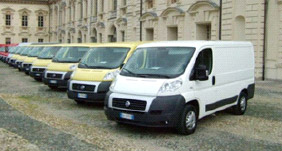OTTAVI srl la sintesi più avanzata di progettazione dedicata a macchine per la trasformazione MT/BT, MT/MT e BT/BT altamente performante,
i dati riferiti alle perdite e le grandezze fisiche di ogni singolo trasformatore, nella sua taglia di riferimento, confermano l'eccellenza
della progettazione.
Le richieste della committenza comportano sempre, nella nostra cultura progettuale, uno studio che culmina in una preventivazione precisa
quanto puntuale, che hanno indotto il polo ingegneristico a creare e catalogare anche le taglie intermedie, destinate ad una posa misurata
per ogni stallo di trasformazione.
Le versioni avanzate delle macchine ad alte prestazioni approdano a perdite ridotte ed efficienza maggiore, tali da superare tutti i limiti
finora prefissati. Eppure, ancora oltre queste soglie, nasce un nuovo studio di progetto, che introduce un concetto di trasformatore così
avanzato da sovvertire i canoni standard ad oggi utilizzati nella consueta logica di calcolo, progetto, esecuzione ed applicazione.
E’ questa la più significativa premessa alla divisionale di produzione resina dedicata alla “ECOSYSTEM”.
Resta affrancata alla quarantennale esperienza dell’azienda la cultura costruttiva dei trasformatori olio che, unitamente ai trasformatori in
resina hanno trovato largo impiego presso:
Costruzioni Edili, Ospedali, Aeroporti, Banche, Centri Commerciali, Supermarket; svariate applicazioni nel Settore Industriale e nel Settore
dei Trasporti e Navale; esecuzioni speciali in Fonderie e Vetrerie, Escavazioni e Trivellazioni, Settore Estrattivo, Olio e Gas; Settore Agricolo,
Linee di Confezionamento, Linee di Assemblaggio e negli ultimi anni negli Impianti Eolici, Fotovoltaici, Biogas.
LA PROGETTUALITÀ
Il trasformatore è una macchina elettrica ad induzione elettromagnetica la cui funzione è quella di trasferire l’energia elettrica tra due diversi
sistemi di tensione alla stessa frequenza. I trasformatori sono disponibili sul mercato in diverse tecnologie costruttive che influiscono in modo
significativo sulle caratteristiche elettriche e sui campi di applicazione. Per una corretta scelta della tipologia è necessario conoscere le diverse
caratteristiche elettriche, termiche e di resistenza alle sollecitazioni dovute a guasti o al normale servizio. Un parametro che occorre tenere in
evidenza per la scelta tra la tipologia in resina e quella in olio, è il regime di funzionamento per cui esso è previsto.
PARAMETRI TECNICI TRASFORMATORI IN RESINA E TRASFORMATORI IN OLIO
1) Sito di Installazione e Sensibilità Ambientale
A causa delle differenze costruttive delle due tipologie, il luogo d’installazione varia significativamente. I trasformatori in olio possono essere
installati sia all’interno che all’esterno e sono resistenti ad agenti atmosferici ed inquinanti, mentre quelli in resina prediligono esclusivamente
una posa interna, protetti da polvere, umidità e con un sufficiente ricircolo di aria.
2) Manutenzione
L’ordinaria manutenzione dei trasformatori varia da una volta all’anno per quelli in resina a due anni per quelli olio. Nel primo caso il controllo
consiste principalmente nella pulizia accurata delle parti sensibili della macchina e ad un controllo dei serraggi, mentre nel secondo caso, oltre
alle operazioni di pulizia e controllo del regolare funzionamento degli eventuali accessori, si preleva un campione d’olio per verificarne il livello
d’isolamento che può variare col passare del tempo e modalità di utilizzo.
3) Perdite e Sovraccarichi
Le perdite nei trasformatori vengono divise in:
P0 = Perdite a vuoto. Perdite legate al nucleo magnetico, è sono sempre presenti fin dall’installazione del trasformatore, indipendentemente dal carico.
Pcc 75°C = Perdite a carico misurate a 75°C. Perdite legate agli avvolgimenti e dipendenti dal carico.
I trasformatori in resina, per caratteristiche costruttive, presentano, rispetto ai corrispettivi trasformatori in olio, P0 maggiori mediamente del 3%
(fino ad un massimo del 15%), ma Pcc nettamente inferiori mediamente del 40% (fino ad un massimo del 60%).
Si evince quindi che nel caso di un utilizzo a bassissimi carichi o nulli è preferibile l’impiego dei trasformatori in olio; in caso contrario è vivamente
consigliato l’utilizzo di trasformatori in resina, in quanto il totale delle perdite durante il regolare esercizio è di molto inferiore. Tale scelta è ancor
più preferibile allorché il funzionamento del trasformatore è interessato a sovraccarichi improvvisi e di breve durata (fino a 50% della potenza nominale),
in quanto più resistente a tali sollecitazioni.
4) Resistenza
I trasformatori in resina, rispetto a quelli in olio, hanno un’elevata stabilità nella resistenza dei fenomeni di cortocircuito, i quali presentano
inoltre un’igroscopicità nulla, facendoli rientrare nella classe ambientale E2.

